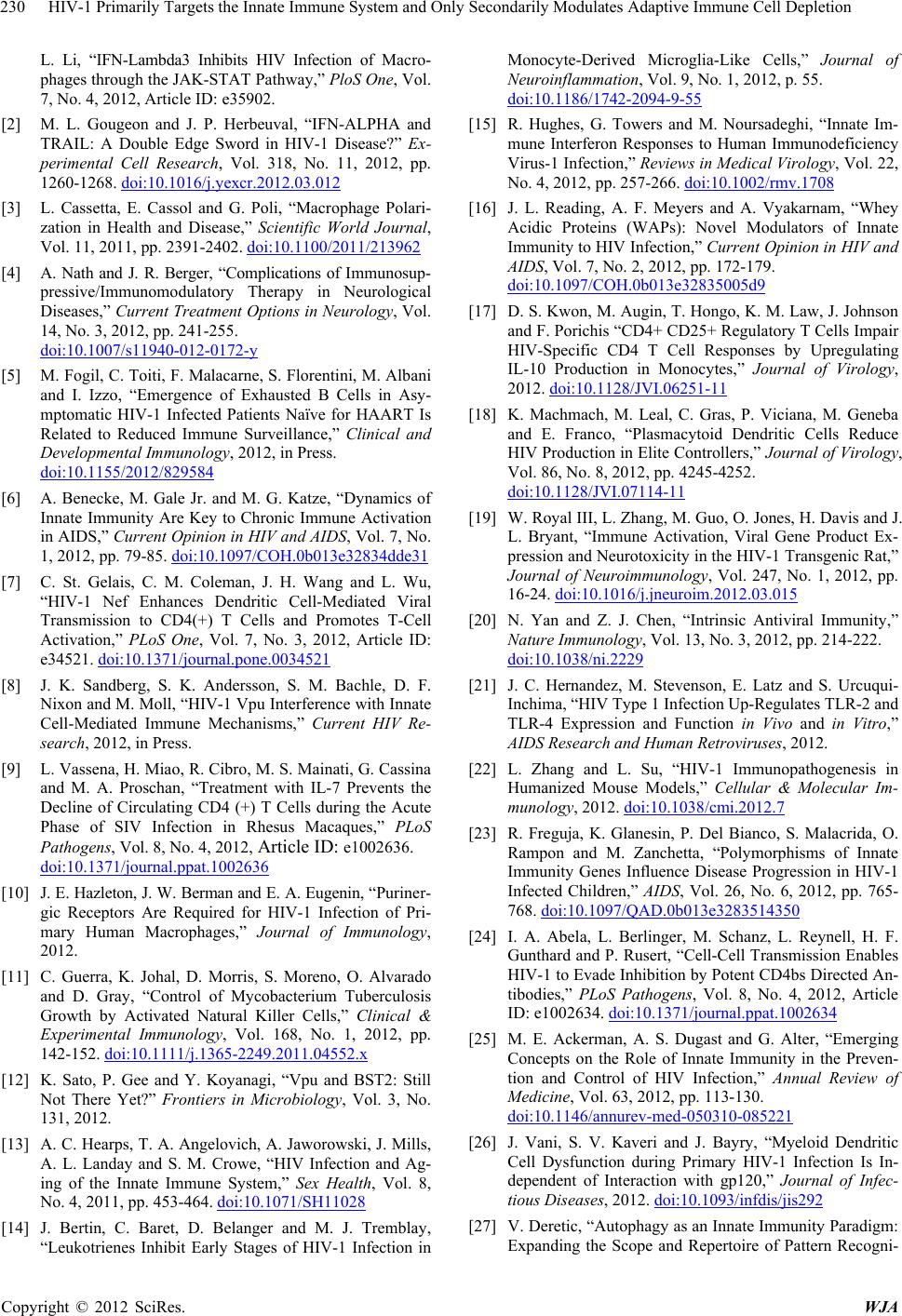
HIV-1 Primarily Targets the Innate Immune System and Only Secondarily Modulates Adaptive Immune Cell Depletion
230
L. Li, “IFN-Lambda3 Inhibits HIV Infection of Macro-
phages through the JAK-STAT Pathway,” PloS One, Vol.
7, No. 4, 2012, Article ID: e35902.
[2] M. L. Gougeon and J. P. Herbeuval, “IFN-ALPHA and
TRAIL: A Double Edge Sword in HIV-1 Disease?” Ex-
perimental Cell Research, Vol. 318, No. 11, 2012, pp.
1260-1268. doi:10.1016/j.yexcr.2012.03.012
[3] L. Cassetta, E. Cassol and G. Poli, “Macrophage Polari-
zation in Health and Disease,” Scientific World Journal,
Vol. 11, 2011, pp. 2391-2402. doi:10.1100/2011/213962
[4] A. Nath and J. R. Berger, “Complications of Immunosup-
pressive/Immunomodulatory Therapy in Neurological
Diseases,” Current Treatment Options in Neurology, Vol.
14, No. 3, 2012, pp. 241-255.
doi:10.1007/s11940-012-0172-y
[5] M. Fogil, C. Toiti, F. Malacarne, S. Florentini, M. Albani
and I. Izzo, “Emergence of Exhausted B Cells in Asy-
mptomatic HIV-1 Infected Patients Naïve for HAART Is
Related to Reduced Immune Surveillance,” Clinical and
Developmental Immunology, 2012, in Press.
doi:10.1155/2012/829584
[6] A. Benecke, M. Gale Jr. and M. G. Katze, “Dynamics of
Innate Immunity Are Key to Chronic Immune Activation
in AIDS,” Current Opinion in HIV and AIDS, Vol. 7, No.
1, 2012, pp. 79-85. doi:10.1097/COH.0b013e32834dde31
[7] C. St. Gelais, C. M. Coleman, J. H. Wang and L. Wu,
“HIV-1 Nef Enhances Dendritic Cell-Mediated Viral
Transmission to CD4(+) T Cells and Promotes T-Cell
Activation,” PLoS One, Vol. 7, No. 3, 2012, Article ID:
e34521. doi:10.1371/journal.pone.0034521
[8] J. K. Sandberg, S. K. Andersson, S. M. Bachle, D. F.
Nixon and M. Moll, “HIV-1 Vpu Interference with Innate
Cell-Mediated Immune Mechanisms,” Current HIV Re-
search, 2012, in Press.
[9] L. Vassena, H. Miao, R. Cibro, M. S. Mainati, G. Cassina
and M. A. Proschan, “Treatment with IL-7 Prevents the
Decline of Circulating CD4 (+) T Cells during the Acute
Phase of SIV Infection in Rhesus Macaques,” PLoS
Pathogens, Vol. 8, No. 4, 2012, Article ID: e1002636.
doi:10.1371/journal.ppat.1002636
[10] J. E. Hazleton, J. W. Berman and E. A. Eugenin, “P uri ne r-
gic Receptors Are Required for HIV-1 Infection of Pri-
mary Human Macrophages,” Journal of Immunology,
2012.
[11] C. Guerra, K. Johal, D. Morris, S. Moreno, O. Alvarado
and D. Gray, “Control of Mycobacterium Tuberculosis
Growth by Activated Natural Killer Cells,” Clinical &
Experimental Immunology, Vol. 168, No. 1, 2012, pp.
142-152. doi:10.1111/j.1365-2249.2011.04552.x
[12] K. Sato, P. Gee and Y. Koyanagi, “Vpu and BST2: Still
Not There Yet?” Frontiers in Microbiology, Vol. 3, No.
131, 2012.
[13] A. C. Hearps, T. A. Angelovich, A. Jaworowski, J. Mills,
A. L. Landay and S. M. Crowe, “HIV Infection and Ag-
ing of the Innate Immune System,” Sex Health, Vol. 8,
No. 4, 2011, pp. 453-464. doi:10.1071/SH11028
[14] J. Bertin, C. Baret, D. Belanger and M. J. Tremblay,
“Leukotrienes Inhibit Early Stages of HIV-1 Infection in
Monocyte-Derived Microglia-Like Cells,” Journal of
Neuroinflammation, Vol. 9, No. 1, 2012, p. 55.
doi:10.1186/1742-2094-9-55
[15] R. Hughes, G. Towers and M. Noursadeghi, “Innate Im-
mune Interferon Responses to Human Immunodeficiency
Virus-1 Infection,” Reviews in Medical Virology, Vol. 22,
No. 4, 2012, pp. 257-266. doi:10.1002/rmv.1708
[16] J. L. Reading, A. F. Meyers and A. Vyakarnam, “Whey
Acidic Proteins (WAPs): Novel Modulators of Innate
Immunity to HIV Infection,” Current Opinion in HIV and
AIDS, Vol. 7, No. 2, 2012, pp. 172-179.
doi:10.1097/COH.0b013e32835005d9
[17] D. S. Kwon, M. Augin, T. Hongo, K. M. Law, J. Johnson
and F. Porichis “CD4+ CD25+ Regulatory T Cells Impair
HIV-Specific CD4 T Cell Responses by Upregulating
IL-10 Production in Monocytes,” Journal of Virology,
2012. doi:10.1128/JVI.06251-11
[18] K. Machmach, M. Leal, C. Gras, P. Viciana, M. Geneba
and E. Franco, “Plasmacytoid Dendritic Cells Reduce
HIV Production in Elite Controllers,” Journal of Virology,
Vol. 86, No. 8, 2012, pp. 4245-4252.
doi:10.1128/JVI.07114-11
[19] W. Royal III, L. Zhang, M. Guo, O. Jones, H. Davis and J.
L. Bryant, “Immune Activation, Viral Gene Product Ex-
pression and Neurotoxicity in the HIV-1 Transgenic Rat,”
Journal of Neuroimmunology, Vol. 247, No. 1, 2012, pp.
16-24. doi:10.1016/j.jneuroim.2012.03.015
[20] N. Yan and Z. J. Chen, “Intrinsic Antiviral Immunity,”
Nature Immunology, Vol. 13, No. 3, 2012, pp. 214-222.
doi:10.1038/ni.2229
[21] J. C. Hernandez, M. Stevenson, E. Latz and S. Urcuqui-
Inchima, “HIV Type 1 Infection Up-Regulates TLR-2 and
TLR-4 Expression and Function in Vivo and in Vitro,”
AIDS Research and Human Retroviruses, 2012.
[22] L. Zhang and L. Su, “HIV-1 Immunopathogenesis in
Humanized Mouse Models,” Cellular & Molecular Im-
munology, 2012. doi:10.1038/cmi.2012.7
[23] R. Freguja, K. Glanesin, P. Del Bianco, S. Malacrida, O.
Rampon and M. Zanchetta, “Polymorphisms of Innate
Immunity Genes Influence Disease Progression in HIV-1
Infected Children,” AIDS, Vol. 26, No. 6, 2012, pp. 765-
768. doi:10.1097/QAD.0b013e3283514350
[24] I. A. Abela, L. Berlinger, M. Schanz, L. Reynell, H. F.
Gunthard and P. Rusert, “Cell-Cell Transmission Enables
HIV-1 to Evade Inhibition by Potent CD4bs Directed An-
tibodies,” PLoS Pathogens, Vol. 8, No. 4, 2012, Article
ID: e1002634. doi:10.1371/journal.ppat.1002634
[25] M. E. Ackerman, A. S. Dugast and G. Alter, “Emerging
Concepts on the Role of Innate Immunity in the Preven-
tion and Control of HIV Infection,” Annual Review of
Medicine, Vol. 63, 2012, pp. 113-130.
doi:10.1146/annurev-med-050310-085221
[26] J. Vani, S. V. Kaveri and J. Bayry, “Myeloid Dendritic
Cell Dysfunction during Primary HIV-1 Infection Is In-
dependent of Interaction with gp120,” Journal of Infec-
tious Diseases, 2012. doi:10.1093/infdis/jis292
[27] V. Deretic, “Autophagy as an Innate Immunity Paradigm:
Expanding the Scope and Repertoire of Pattern Recogni-
Copyright © 2012 SciRes. WJA